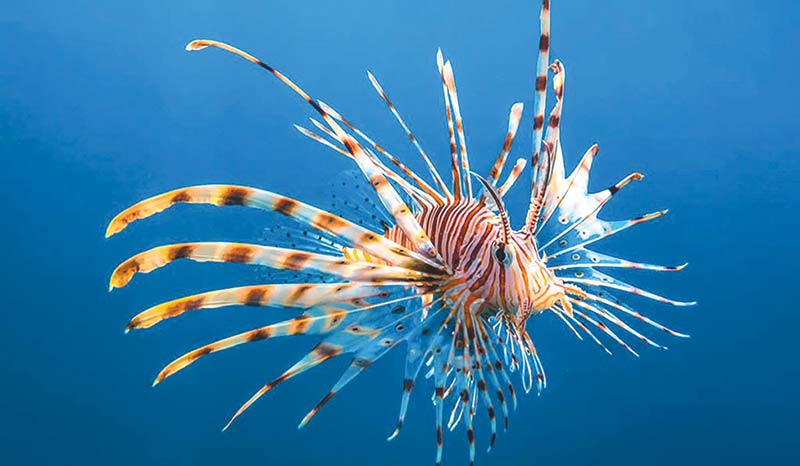Lionfish Stings

By Divers Alert Network
With their fanlike fins and melancholy stares, lionfish are now a fixture at many popular dive sites in the Caribbean and Atlantic. Though native to the Indo-Pacific, their populations exploded throughout the Atlantic due to a lack of predators. In addition to wreaking havoc on ecosystems and gobbling up native fishes, lionfish can be a threat to divers because of their venomous spines.
Even where lionfish now proliferate, envenomations are rare, but recognizing the hazard they present and keeping your distance are important in injury prevention. Whether you’re just going for a dive in the Caribbean or embarking on a lionfish hunt, you should understand the basics of managing lionfish injuries.
The invasive lionfish
The pervasiveness of lionfish is likely the result of aquarium owners dumping unwanted individuals into nearby coastal waters. They’re slow-moving and rely on their colouration and spines to elude potential predators. They are active hunters, however, and eat over 50 species of fish, taking away precious resources from native predators. Lionfish hunting is one of the best management techniques for population control and can be done by spearfishers. As a bonus, lionfish are quite tasty!
Mechanism of injury
A lionfish has 18 venomous spines—13 dorsal, three anal, and one on each pelvic fin. Venom-producing glands are found on the upper two-thirds of these spines. Contact with lionfish can occur during diving, fishing, and even food handling. When a spine penetrates the victim’s skin, venom flows into the wound. Most lionfish stings are relatively benign, but some require urgent medical intervention.
The affected area will immediately become swollen, and this will generally last for two to three days. Pain is also common but will dissipate within a few hours. Discolouration of the area can last for a week. Other common symptoms include redness, edema, localized heat, blisters, dead tissue, nausea, vomiting, dyspnea, fever, and muscular weakness.
The best way to avoid any marine animal injury is to simply leave animals alone and not get too close. But if you’re hunting lionfish, you’ll likely be putting yourself within range of their spines. Shears can be carried underwater to trim off the venomous spines, but a puncture-proof container is probably a better bet. Using a container is more effective than trimming because divers sometimes clip off nonvenomous fins and leave some venomous ones behind. Spearing and placing the fish into the container is more efficient.
Lionfish stings can happen out of the water, too. When handling these fish, make sure you’re wearing puncture-proof gloves and paying attention to how you’re handling the fish.
Injury treatment
Response to a lionfish sting should be swift. Exit the water safely—if diving, perform a normal ascent, fulfilling any decompression obligation. Once out of the water, start by cleaning the wound thoroughly with fresh water and soap. Remove any foreign material that may have entered the wound and control any bleeding. Pain can be controlled by immersing the affected area into hot—yet tolerable—water for 30 to 90 minutes. (Don’t scald the injured person.) Repeat as needed. Intense pain from the wound may impact someone’s ability to discriminate between hot and scalding water—have an uninjured person test the water on the same part of their own body to ensure it’s not too hot.
Ice packs can be applied to control pain and swelling, and pain medication can be taken. If a topical antibiotic is available, it can be applied, too. It’s also recommended to seek a professional medical evaluation. And if severe symptoms arise, call emergency medical services.
While invasive lionfish populations can be controlled, eradication may not be entirely possible. Divers can certainly do their part in thinning their numbers while staying safe around the invasive fish.
For more safety information on safe diving practices visit: www.dan.org







